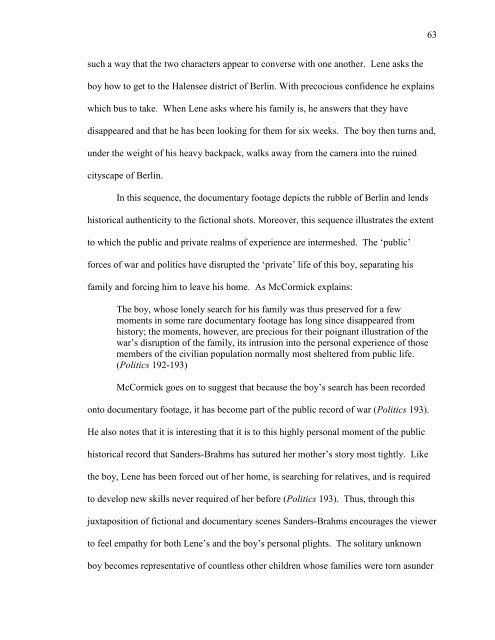'Murderer's House' - University of Victoria
'Murderer's House' - University of Victoria
'Murderer's House' - University of Victoria
Create successful ePaper yourself
Turn your PDF publications into a flip-book with our unique Google optimized e-Paper software.
such a way that the two characters appear to converse with one another. Lene asks the<br />
boy how to get to the Halensee district <strong>of</strong> Berlin. With precocious confidence he explains<br />
which bus to take. When Lene asks where his family is, he answers that they have<br />
disappeared and that he has been looking for them for six weeks. The boy then turns and,<br />
under the weight <strong>of</strong> his heavy backpack, walks away from the camera into the ruined<br />
cityscape <strong>of</strong> Berlin.<br />
In this sequence, the documentary footage depicts the rubble <strong>of</strong> Berlin and lends<br />
historical authenticity to the fictional shots. Moreover, this sequence illustrates the extent<br />
to which the public and private realms <strong>of</strong> experience are intermeshed. The „public‟<br />
forces <strong>of</strong> war and politics have disrupted the „private‟ life <strong>of</strong> this boy, separating his<br />
family and forcing him to leave his home. As McCormick explains:<br />
The boy, whose lonely search for his family was thus preserved for a few<br />
moments in some rare documentary footage has long since disappeared from<br />
history; the moments, however, are precious for their poignant illustration <strong>of</strong> the<br />
war‟s disruption <strong>of</strong> the family, its intrusion into the personal experience <strong>of</strong> those<br />
members <strong>of</strong> the civilian population normally most sheltered from public life.<br />
(Politics 192-193)<br />
McCormick goes on to suggest that because the boy‟s search has been recorded<br />
onto documentary footage, it has become part <strong>of</strong> the public record <strong>of</strong> war (Politics 193).<br />
He also notes that it is interesting that it is to this highly personal moment <strong>of</strong> the public<br />
historical record that Sanders-Brahms has sutured her mother‟s story most tightly. Like<br />
the boy, Lene has been forced out <strong>of</strong> her home, is searching for relatives, and is required<br />
to develop new skills never required <strong>of</strong> her before (Politics 193). Thus, through this<br />
juxtaposition <strong>of</strong> fictional and documentary scenes Sanders-Brahms encourages the viewer<br />
to feel empathy for both Lene‟s and the boy‟s personal plights. The solitary unknown<br />
boy becomes representative <strong>of</strong> countless other children whose families were torn asunder<br />
63

















